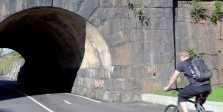A deep railway canyon splitting the urban fabric is converted into a pedestrian and bicycle corridor in a resource-saving collaborative process that also respects the memory of an industrial past.
[Katharina Ritter, coordinator of exhibition programmes at the Architekturzentrum Wien (AzW) | Duration: 01:57]
TECHNICAL SHEET
Authors: Helsinki City Planning Department | Helsinki Public Works Department | Loci Landscape Architects Ltd
Country: Finland
Surface: 16.000 m2
Cost: 5.000.000 €
Project: 2003
Work: 2009
End of work: 2012
DESCRIPTION
In 1894 a railway line was constructed on the edge of the Helsinki city centre, running between the central station and Länsisatama (“West Harbour” in Finnish). This required the excavation of an open-air canyon of seven metres deep and almost a kilometre and a half long. Helsinki subsequently expanded, surrounding the cutting which, although crossed by seven bridges, still constituted a gash in the urban fabric. In 2008, the cargo port was moved to the Vuosaari neighbourhood and work began on a new residential zone in Länsisatama. The railway connection was no longer necessary and questions about the future of the cutting were being asked.
Covering the canyon to make an underground tunnel would restore continuity to the urban layout, but this option is expensive and will take time. Meanwhile, in a process that has involved residents, university students and a range of municipal departments, the space has been temporarily converted into a corridor for pedestrians and cyclists. Linking Länsisatama with the city centre by way of a series of landscaped areas pervaded with railway motifs, the track has been named “Baana”, or “Rail” in colloquial Finnish. Bike lanes have been asphalted and access has been provided from both sides, although the original tracks and stone walls have been conserved. The rugged darkness of the cutting contrasts with nearby sports and artistic installations in colours as bright as those of the goods containers that used to move along the track.
Austere, versatile and resistant, this recycling of the railway track has been embraced by very different kinds of users. It is so successful that widened bike lanes are now being considered, and even the possibility of extending a “Baana network” of similar tracks throughout the city. Fruit of a complex process of cooperative endeavour involving the administration, academics and residents, this example of temporary urban planning safeguards industrial memory, saves resources for the future, and also establishes a non-commercial shared space. With this successful balancing of costs and benefits it would seem that the eventual project of covering of the cutting can wait.
David Bravo, architect




